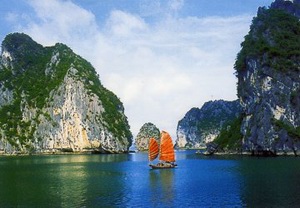Natural beauty of Halong Bay
 With its spectacular archipelago of islands towering out
of misty water, Halong Bay takes the breath away with
its mysterious yet enchanting beauty. These 3,000
naturally-formed limestone pillars, known as karst, are
what make Halong Bay a unique place not found anywhere
else in the world, and recognized by UNESCO as a World
Heritage Site in 1994. Here, you can explore a landscape
of fascinating caves, arches and lakes, filled with rare
wildlife.
With its spectacular archipelago of islands towering out
of misty water, Halong Bay takes the breath away with
its mysterious yet enchanting beauty. These 3,000
naturally-formed limestone pillars, known as karst, are
what make Halong Bay a unique place not found anywhere
else in the world, and recognized by UNESCO as a World
Heritage Site in 1994. Here, you can explore a landscape
of fascinating caves, arches and lakes, filled with rare
wildlife.
Karst are not unique in Asia, as these limestone towers
are also found in Thailand's Krabi island and China's
Guilin region. But Vietnam's Halong Bay leaves other
karst formations in the dust, as the islets here fill
the entire bay as far as the eye can see, almost like a
civilisation that has been drowned by the ocean. Some of
these islands are also so large that they have lakes,
beaches and forests filled with animals.
Located in Northeastern Vietnam, Halong Bay is 165
kilometers from Vietnam's capital, Hanoi, and forms a
part of the Gulf of Tonkin. It is possible to arrive by
land via Halong City, but the best way to come is
actually by boat from Hanoi, which also offers lovely
sea views on the way and the opportunity to spend a
night sleeping on a boat. International cruises also
frequently come this way, bringing visitors to shore to
visit the islands.
With its mild tropical climate, Halong Bay is a great
place to visit at any time all year round. It does have
a winter season, but temperatures typically hardly ever
dip below 10-C, usually staying between the range of
15-C to 25-C. Frequent rainfall in the months of
February, March and April mean that the air in the bay
will feel moist but cool, and a romantic fog will fall
over the water, shrouding the islands in its distinctive
mist. In the hotter months, visitors should expect
sudden thunderstorms, which can affect cruises and water
activities depending on severity.
It is unlikely today to see any dragons in Halong Bay,
but the bay is a place full of biodiversity. The islands
and coastline are covered with beautiful rainforests
where wildlife lovers can spot many species of colorful
birds and amphibians. Underwater, it is a marine
paradise of corals and many endangered species of fish
and marine animals, including the dugong.
Unfortunately, the natural wealth and beauty of Halong
Bay has also made it a target for those who wish to
exploit its resources. Today, it is in danger of losing
much of its magnificent aura due to the pressure of
overfishing and hunting in the area. Game hunters are
fast reducing the populations of rare animals, while
many precious coral and shells in the sea are being
ripped out to turn into souvenirs and trinkets for
tourists.
Halong boat cruises - The government has tried to put a
stop to this by creating national parks and reserves to
protect the bay, but visitors can play a part by
rejecting wasteful exploitation and embracing a more
environmentally-friendly form of eco-tourism. Only then
can they ensure that the beautiful Halong Bay will
remain a treasure that can be kept for future
generations to come.
 Read more
Read more











